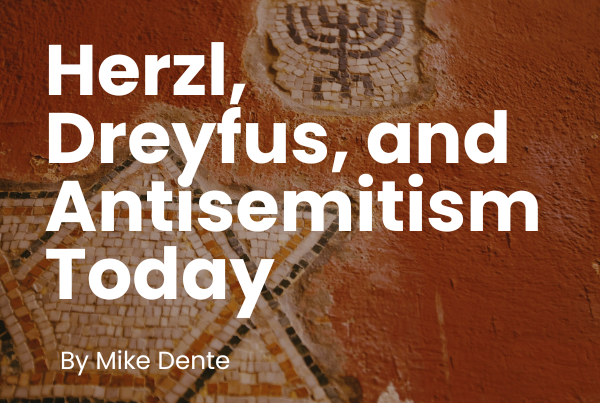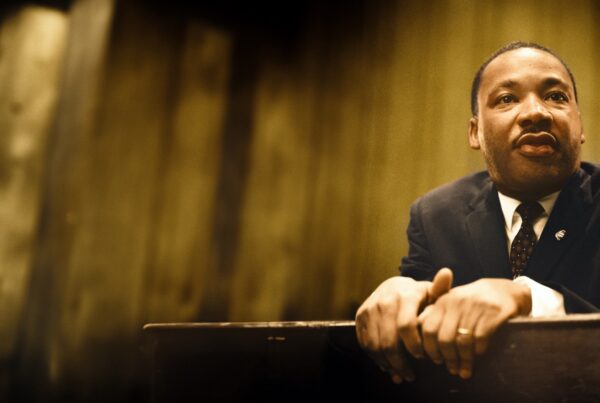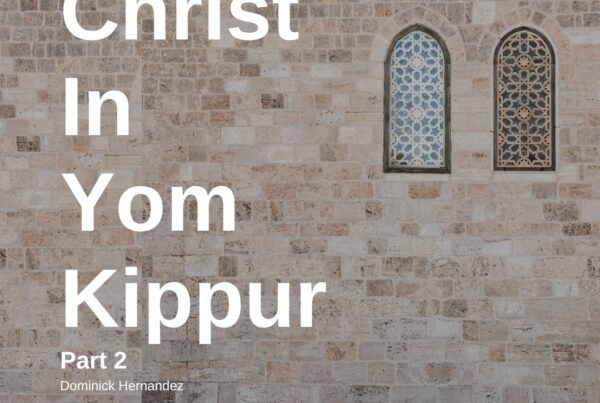
When a spiritual revival swept through England in the 19th century, it also revived a love for the Jewish people and prayers for their restoration. One brave mother, a product of the earlier Great Awakening revival, taught her young son to pray for Israel and the peace of Jerusalem and those who love Israel: “May they prosper who love you” (Psalm 122:6).
Daily they knelt by his bed and prayed, “O Lord, we would not forget Thine ancient people, Israel; hasten the day when Israel shall again be Thy people and shall be restored to Thy favor and to their land.”1 On December 9, 1917, on the eve of Hanukkah, an answer to their prayers began to unfold. A phalanx of British officers led by General Edmund Allenby (1861-1936) entered Jerusalem. As a gesture of respect, Allenby stepped down from his horse and walked in. He deliberately chose to walk, he stated, because only the Messiah should ride into the Holy City.2
The grip of the Turkish Empire, which had ruled for some 400 years, crumbled, and Jerusalem was now in the hands of Britain, a nation sympathetic to their plight. Israel’s restoration had begun.The young boy who prayed with his mother by his bed grew up to be General Allenby. He not only witnessed this miracle, but also became part of the answer to his boyhood prayers.
The Stage Was Set
Earlier, November 1917, the Balfour Declaration had been issued by the British government and adopted by the League of Nations, establishing the boundaries of a new Jewish state in the Palestine area.
Thirty years and another World War later, on November 29, 1947, Resolution 181, the official UN act to partition Palestine, allotted the new Jewish state a small part of western Palestine. The resolution recognized the right of the Jewish people to a state, not just a “national home” as the Balfour Declaration stated.
My close friend, the late Mayor Ron Nachman of Ariel, Israel, told me about the night Resolution 181 was celebrated. “I was five years old, but I remember everything. The celebration, the joy, the happiness, the dancing in the street. Then the next day, the riots began.” Ron experienced the joy, followed by the terror of continuing conflict as he literally grew up with the state of Israel.
On May 14, 1948, the British mandate over Palestine expired. A proclamation was approved, declaring the establishment of the state of Israel. The United States recognized the new nation that same night. The dry bones of Ezekiel’s prophecy had come together (Ezekiel 37). “Sinews and flesh” gave the bones physical substance. The nation was restored to its physical state. But there was “no breath,” Ezekiel observed. Then God began breathing life into the Holy Land, through men and women like Ron Nachman, his family and fellow citizens.
Patterns
J. Vernon McGee once commented, “Prophecy is the mold into which history is poured.” The Hebrew mindset identifies patterns in Scripture and history. Prophecy is best understood when we recognize those patterns. On the world stage, with Israel’s re-birth, God was moving, revealing some interesting historic patterns.
Consider this:
Jesus connected His coming Kingdom to the Genesis flood saying, “But as the days of Noah were, so also will the coming of the Son of Man be.” Noah, whose name means “rest” or “comfort,” spent 120 years building an ark according to the Lord’s instructions. He was no doubt jeered, questioned and ridiculed as he warned people of impending judgment. His ark provided safe shelter for his family and prepared them for the task of rebuilding their world after the flood.
Jesus, the One who offers rest to the weary, made the connection to Noah (Matthew 11:28). His Kingdom will finally bring sanctuary and comfort to the world.
A New Ark
In 1897 Theodor Herzl, known as the father of Zionism, began to build a new “ark” by organizing the first Zionist Congress in Basel, Switzerland. Zion is the ancient name for Jerusalem.
The stated primary goal was to aim at “establishing for the Jewish people a publicly and assured home in Palestine.”3 The year 2017 marks 120 years since Herzl began to build the new ark, Israel, a sanctuary and homeland for a weary chosen people.
A 50-Year Pattern
Fifty years is significant in the Jewish calendar. The 50th year was the Year of Jubilee, when bond slaves were released, land restored and debts forgiven. A holy, life-giving year. Herzl wrote in his diary, “In Basel I founded the Jewish State…maybe in five years, certainly 50, everyone will realize it.” Resolution 181 and the historic night Ron Nachman recounted to me, was passed exactly 50 years later in 1947.
The Six-Day War that put East Jerusalem and the Temple Mount back into the hands of the Jewish people followed the miracle of General Allenby’s liberation of Jerusalem in 1917 by exactly 50 years, in 1967. The Six-Day War was a milestone for me, when at age 11 I saw the dramatic headlines of Israel’s miraculous victory. My interest in Israel and prophecy grew as the ancient land of the Bible took on flesh and bones.
The 1967 Six-Day War is as miraculous as the story of Joshua and Jericho. In one week, both wars saw the political, military and geographical walls tumbled down by supernatural power! It was an emotional, powerful episode in Israeli history described by reporter Mordechai Twersky: “You hear the sounds of gunfire. You hear the footsteps of Israeli soldiers, as they draw closer and closer…We hear a triumphant Brigadier General Shlomo Goren, later to become the Chief Rabbi of Israel, as he recites the memorial prayer and sound the shofar, as Israeli soldiers weep with sorrow over their comrades killed in combat.”
Amidst the sounds of weeping, gunfire and shofars, the Rabbi cried, “This year in a rebuilt Jerusalem! In the Jerusalem of old!”4
Fast forward 50 more years to 2017. President Trump officially recognized Jerusalem as the capital of Israel and directed the State Department to begin preparation to move the American Embassy from Tel Aviv to Jerusalem 100 years after the Balfour Declaration and 120 years after Herzl began to build the new ark, Israel, as a homeland for a weary people. God is calling His people back to the Promised Land, from all over the world, beckoning them to “the ark.”
No matter how you slice it–120 years, 100, 50 or 70–all are converging in 2018 to celebrate the anniversary of God’s chosen land for His chosen people!
Spiritual Explosion
A significant spiritual principle pervades historic events involving the Jewish people. God promised Abraham, “In you all the families of the earth shall be blessed” (Genesis 12:3). Every time God fulfills prophecy concerning the Jewish people and Israel, He pours out His Spirit in a fresh way upon the church. Within seven years of the Zionist Congress, God began to move through revivals like the Welsh Revival and Azusa Street in Los Angeles. The 20th century progressed through two World Wars, “nation against nation.” The prophet Isaiah’s question, “Can a country be born in a day?” (Isaiah 66:8, NIV), was answered when Israel was recognized as a nation on May 14, 1948.
In 1949, 29-year-old Billy Graham conducted a crusade in Los Angeles that launched his evangelism ministry. Two years later, Bill Bright, also 29, launched a worldwide ministry called Campus Crusade for Christ. Right after the Six-Day War in 1967, the Jesus Movement revival captured a generation’s heart, including mine, and the modern Messianic movement was born as thousands of Jews accepted Jesus as their Messiah.
Window of Time
As we celebrate the 70th anniversary of Israel on May 14, we will have entered a historic and unique window of time, one that overlaps 2017-2018 (this is the Hebrew year 5778, which started in September 2017 and runs to September 2018). We are living in a time of unprecedented growth for the Gospel.5 The outpouring of God’s Spirit will continue to reach deeper and wider into the world as people hunger for the truth.
The prophet Joel made a promise that Peter repeated in his Pentecost sermon:
“And it shall come to pass in the last days, says God, that I will pour out of My Spirit on all flesh; your sons and your daughters shall prophesy, your young men shall see visions, your old men shall dream dreams. And on My menservants and on My maidservants I will pour out My Spirit in those days; and they shall prophesy” (Joel 2:28-29; Acts 2:17-18).
The Hebrew word used for pour means to “spill, mound up, intensely gush out in abundance.” The promise, however, hinges on an era–the last days. We have entered that era, a window in time when Israel is celebrated, and God is pouring out His Spirit upon the world. No more business as usual! Our sons and daughters will see visions and prophesy. The older ones of us will dream and see the future!
Jesus said this to His disciples about the fig tree, a symbol of Israel: “When its branch has already become tender and puts forth leaves, you know that summer is near. So you also, when you see all these things, know that it is near-at the doors!” (Matthew 24:32). “It” refers to the end of the age and His Second Coming.
We do not know the day or hour, but we know our Lord is coming soon (Matthew 24:42). And Israel is the sign that we need to be ready. For 70 years, the fig tree has blossomed into the beautiful homeland and the ark God promised-120 years from the dream of Theodor Hertzl. We celebrate this anniversary and this season with great joy and anticipation!
“Great is the Lord, and greatly to be praised in the city of our God, in His holy mountain. Beautiful in elevation, the joy of the whole earth, is Mount Zion on the sides of the north, the city of the great King” (Psalm 48:1-2).
1 Barry Shaw, “1917 and the Liberation of Jerusalem,” Jerusalem Post, November 19, 2017. Web.
2 Ibid.
3 Gotthard Deutsch, “Basel Program,” Jewish Encyclopedia. Web.
4 “The Six-Day War,” Jewish Virtual Library. Web.
5 Philip Jenkins, The Next Christendom: The Coming of Global Christianity, 3rd Ed. New York. Oxford University Press, 2011, pp. 2-3.






